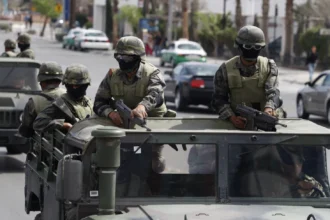An Iranian cargo ship believed to be a base for the paramilitary Revolutionary Guard and anchored in the Red Sea off Yemen for years has been attacked, according to Iranian state television on Wednesday.
The acknowledgment by state television, citing foreign media, is the first Iranian comment on the mysterious incident involving the MV Saviz. The ship’s long presence in the region, which Saudi Arabia has repeatedly criticized, comes as the West and UN experts claim Iran has provided arms and support to Yemen’s Houthi rebels during the country’s years-long conflict.
Iran previously stated that the ship was assisting in “anti-piracy” efforts in the Red Sea and the Bab el-Mandeb strait, a critical chokepoint for international shipping.
An anchor in the state TV statement cited a New York Times story published Wednesday, in which an anonymous US official told the newspaper that Israel warned America about a planned attack on the vessel. When contacted by The Associated Press late Tuesday night, Israeli officials declined to comment on the incident.
The attack was reported late Tuesday by Iran’s semiofficial Tasnim news agency, which is believed to be close to the Guard, who said explosives planted on the hull of the Saviz exploded. It did not blame anyone for the attack and stated that Iranian officials would most likely provide more information in the coming days.
The US military’s Central Command only said in a statement that it was “aware of media reporting of an incident involving the Saviz in the Red Sea.”
The command stated, “We can confirm that no US forces were involved in the incident.” “We have no further information to offer.”
According to ship-tracking data, the Saviz, owned by the state-linked Islamic Republic of Iran Shipping Lines, arrived in the Red Sea in late 2016. It has drifted off the Dahlak archipelago, a chain of islands off the coast of the nearby African nation of Eritrea in the Red Sea, in recent years. It most likely received supplies and crew changes from passing Iranian vessels on the waterway.
Briefing materials obtained earlier by The Associated Press from the Saudi military showed men on the ship dressed in camouflage and military fatigues, as well as small boats capable of ferrying cargo to the Yemeni coast. That briefing material also included images of the vessel’s antennas, which the Saudi government described as unusual for a commercial cargo ship, implying it conducted electronic surveillance.
The Saviz has been described as a “Iranian mothership” in the region by the Washington Institute for Near-East Policy, as well as an intelligence gathering base and an armory for the Guard. The institute’s policy papers don’t explain how they arrived at that conclusion, despite the fact that its analysts have regular access to Gulf and Israeli military sources.
The Saviz had been subject to international sanctions until Iran reached a nuclear deal with world powers in 2015, in which Tehran received economic relief in exchange for limiting its uranium enrichment. The Trump administration later renewed American sanctions against the Saviz as part of its decision to withdraw unilaterally from the agreement.
In June 2019, Saudi Arabia flew a critically ill Iranian off the Saviz after Tehran requested assistance through the United Nations.















